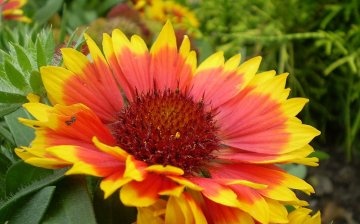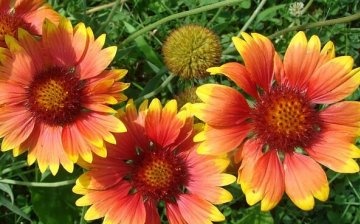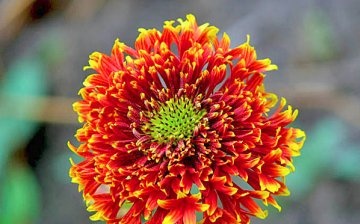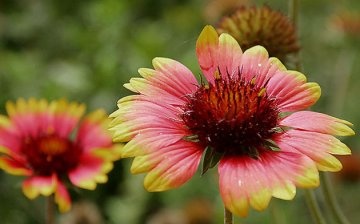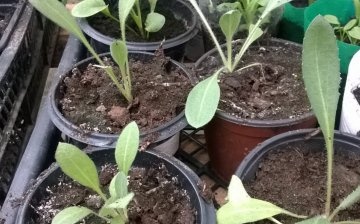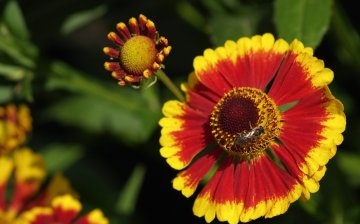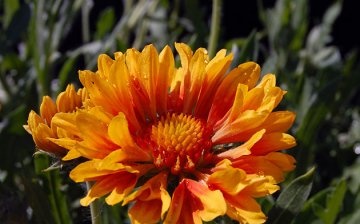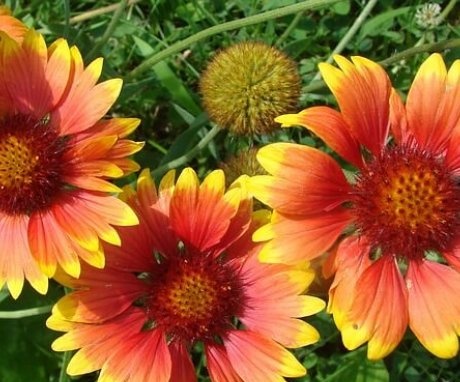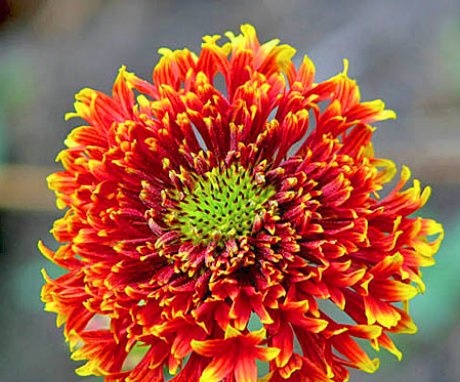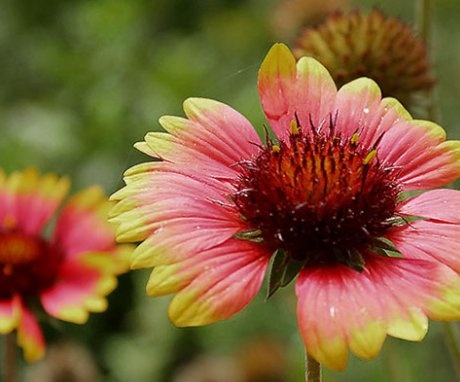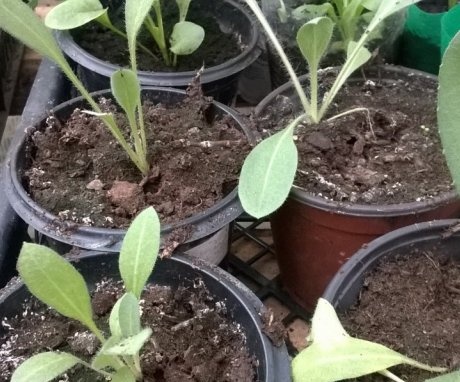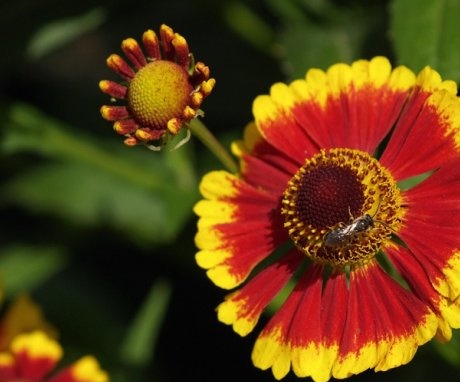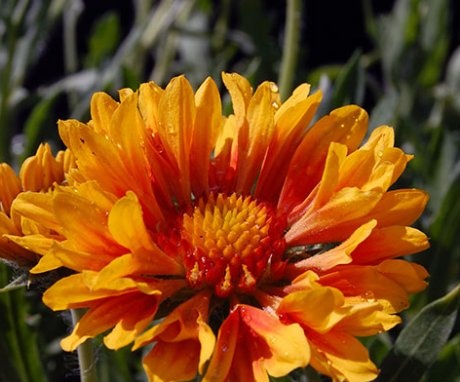Gaillardia perennial - a charming fire flower in the garden
Gaillardia belongs to the Aster family and is considered a native of America. The flower got its name in honor of the Frenchman Gaillard de Marentonu, who was a botanical patron of the arts in the 18th century.
The American state of Oklahoma has chosen the flower as an official symbol and there Gaillardia is named firewheel - a wheel of fire, because its bloom resembles a fire that quickly spreads over the prairie and covers the entire free space with a dense blanket of large sun heads.
Content:
- Description of perennial Gaillardia
- Variety of species and varieties
- Gaillardia breeding methods
- Sowing seeds for seedlings and transplanting into open ground
- Gailardia Care Tips
- Disease and pest control
Description of perennial Gaillardia
An ancient legend of Indian tribes tells about the origin of Gaillardia. In one of these tribes, a craftsman lived who made beautiful bedspreads that served the Indians both for outerwear and for the burial savannah. When the weaver felt the approach of death, he made his last veil, in which he was buried. The weaver presented the veil made in yellow, red and brown tones to the Great Spirit, who liked the work so much that he ordered that the old man's grave be decorated with flowers of the same shades.
In the spring, the grave of the Indian was decorated with amazing flowers of sunny shades and very quickly spread throughout the lands of the tribe. The flower was named Indian blanketflower - Indian flower blanket.
As a garden culture, perennial Gaillardia is unpretentious in care.
It tolerates drought and heat well, many varieties are quite resistant to frost. Today there are about 20 varieties of plants. Flowers can be perennial and annual, with semi-double or double flowers, monochromatic and bi-colored. The buds are tied at the ends of branched stems. When the plants shed their color, seed pods remain on the branches.
Perennial Gaillardia is a small bush 0.5-0.7 meters in height, consisting of elongated sheets with jagged edges. Due to its decorative qualities and the duration of flowering, which begins in June and can last until frost, Gaillardia has won the love of gardeners.
Variety of species and varieties
The variety of species and hybrid varieties of Gaillardia with a rich palette of colors allows it to be cultivated both for garden decoration and for cutting. The following types of perennial beauty have gained particular popularity:
- Gaillardia aristata push. Almost all existing varieties of perennials originated as a result of the selection of spicy Gaillardia with wild species. It is a shrub plant with monochromatic and two-colored heads of single flowers, reaching a diameter of 10-12 cm. Flowers can be tubular and ligulate from bright golden to crimson shades. Stems are erect with densely planted leaves.
- Dazzer (Dazzier) is a shrub 50-70 cm high with dissected leaves. Single ligulate flowers of yellow, orange and red colors.Recommended for group boarding.
- Arizona Apricot - grows up to 30 cm, characterized by apricot-colored petals with yellow tips.
- Mandarin (Mandarin) - has bright orange reed inflorescences.
- Croftwav Yellow - Famous for its bright golden-sunny inflorescences.
- Viral flame (Wirral Flame) - is distinguished by an unusual color of red petals with golden tips.
Hybrid Gaillardia. This group was bred as a result of the selection of a sharp and beautiful Gaillardia. The bush is quite tall. Forms terry inflorescences of golden and brick shades. Bloom continues for two months.
The following varieties of hybrid Gaillardia are common:
- Bremen (Bremen) - 50-60 cm high with reed flowers of dark red with a yellow edging color and yellow-purple tubular.
- Burgundy (Burgundy) - grows up to 60 cm and forms inflorescences with a diameter of 10 cm deep red with a brownish and yellow core.
- Goblin (Goblin) - undersized shrub no more than 35 cm. Forms inflorescences of a creamy raspberry color.
- Golden Goblin is a dwarf hybrid that grows up to 40 cm. It is characterized by large inflorescences of bright golden shades. Suitable for decorating an alpine slide.
- Kobold - low highly branched bushes up to 40 cm are decorated with ten-centimeter heads of reed flowers with fiery petals topped with burgundy tips.
Gaillardia breeding methods
For the reproduction of perennial Gaillardia, several methods are applicable:
- Seminal. To obtain seed, it is necessary to leave seed pods on the most beautiful and bright bushes until autumn, from which the seeds are taken out, if necessary, they are dried and stored in fabric bags in a dry place until sowing. Sowing seed seedlings are produced in mid-spring. Due to the easy tolerance of cold climates, seeds can be sown directly into open ground, while they do not need to be deeply buried. After 2 weeks, the first shoots of seedlings will appear, which needs moderate and regular irrigation, because the shrub does not like excessive moisture. After three months, the seedlings will be ready for planting in a place prepared for it in the garden. When sowing seeds immediately to a permanent place, the hardened seedlings must be thinned out, leaving an interval between the bushes of at least 15 cm.If the roots of the extracted shoots are not damaged, then they can be planted in an empty place.
- Division of the bush. Using the method of dividing the bush, the plant is dug up and the rhizome is carefully divided into several parts, each of which must have developed roots. Most often, the bushes are divided into three parts. After the performed manipulations, the flowers are planted in the prepared areas.
- Cuttings... Experienced flower growers use the cuttings method. In this case, you need to dig around the perimeter, cut off a larger and healthier part of the root, which is subsequently cut into fragments of at least 5-7 cm and placed in a greenhouse for rooting.
- Self seeding. The easiest way to reproduce Gaillardia is self-seeding. At the same time, after flowering, several selected testicles are left on the bushes, from which the seeds will subsequently spill out into the ground and rise the next year. When using the self-seeding method, it should be borne in mind that the sprouts that have appeared must be planted in a timely manner.
Sowing seeds for seedlings and transplanting into open ground
The place for planting Gaillardia should be well lit and have a suitable soil composition. The process does not require special skills due to the unpretentiousness of the plant.
The main condition is that the soil must be light and well-drained.
Before planting, to increase looseness, it is recommended to add a small amount of ash and sand to the garden soil. If the soil is poor or severely depleted, then it is added compost or humus. The most optimal soil composition is loam and sand in a ratio of 3: 1.
To obtain early flowering plants, seeds for seedlings are sown in late winter or early spring:
- Seed material is laid out in planting containers with a richly moistened substrate, sprinkled with earth a little, covered with polyethylene and sent to a lighted room with a temperature of 20-25 degrees.
- After emergence, the seedlings are moved to a cool place and grown at a temperature of 18-21 degrees.
- When the first pair of leaves appears, the seedlings must be planted by increasing the spacing between plants or in individual containers.
- Watering carry out moderate after complete drying of the topsoil. Additional backlight, to increase daylight hours up to 14 hours.
At the end of spring, the seedlings are ready for transplant into open ground. Seedlings are planted in prepared soil at intervals of 35-45 cm and watered well. If all conditions are met, the plants will release color after 4-5 months. Gaillardia perennial is a drought-resistant plant. Due to this fact, irrigation must be carried out carefully: in small quantities as the soil dries out. They increase the amount of introduced moisture only during severe drought.
The shrub should be fed in three stages, introducing complex mineral fertilizers... The introduction of fresh manure should be avoided. The first feeding is applied during the period of bud formation, the second - during the flowering period and the third - after the end of flowering.
Gailardia Care Tips
Gaillardia is an unpretentious creature that loves the sun very much, grows well on sandy soils, easily tolerates drought and winter cold. However, in order for Gaillardia to please with abundant color throughout the season, it is worth adhering to some rules:
- moderate irrigation - do not overflow, otherwise the plant may die
- three times feeding during the season using mineral fertilizers, without making organics
- to extend the flowering time, faded buds should be removed, and tall varieties should be tied up
- in areas with severe winters, the bushes should be covered with spruce branches from dry foliage, needles, straw or peat, after cutting off all flower stalks, and the first-year bushes are completely cut off
- every 2-4 years it is recommended to divide the bushes in spring or autumn. Gaillardia can live in one place for no more than five years without a transplant.
- timely removal of weeds, especially tall, which can shade the plant
- loosening helps to provide the roots with the necessary oxygen
When deviating from the elementary rules, the plant can begin to hurt and be amazed. pests.
Disease and pest control
Like all living things, Gaillardia perennial is at risk diseases... Diseases can affect flowers if the rules of planting and care are not followed. Excessive moisture, due to overflow or rainy weather, contributes to the development of diseases such as gray rot, powdery mildew, white rust. Plant leaves especially suffer from ailments.
Also, gailardia can be attacked by harmful insects, especially dangerous aphids, thrips, grinders and whiteflies.
When the first signs of damage or disease of flowers appear, radical measures should be taken to treat the plants. Spraying with manganese solution and treatment with chemicals copes well with this task. In case of extensive damage, the affected bushes should be removed and destroyed.
The unpretentious overseas beauty Gaillardia has found wide application in landscape design due to its long and bright flowering. It is actively cultivated for decorating flower beds and flower beds, borders and rabatoks, alpine slides and group plantings. Amateur flower growers plant beautiful flowers in the local area to decorate the site and for bouquet cutting. This does not require special knowledge and skills.
More information can be found in the video:



